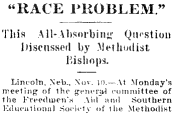|
|
 |
 |
|
Reading Guide |
| 2. |
"Race Problem"
| - | Clara Ann Thompson, "Uncle Rube on the Race Problem," poem, 1900 |
| - | Frederick Douglass, "The Race Problem," address, 1890, excerpts |
| - | Winslow Homer, The Gulf Stream, oil on canvas, 1899 |
|
|
 1903 |
"How does it feel to be a problem?"—the question with which Du Bois begins The Souls of Black Folk—is our focus here. How did African Americans respond to the white-defined "problem"? How did they redefine it from their perspective? And how did they cope with the real threat of violence that haunted even the discussion of the issue? We begin with "Uncle Rube on the Race Problem" by Clara Ann Thompson, the daughter of former slaves and a lifelong poet. In 33 four-line stanzas, Thompson creates the response of "Uncle Rube" to a group of white men who question him on the "race problem." Next we read a speech by Frederick Douglass to a African American literary and historical association in Washington, D.C. We usually read Douglass while studying slavery and abolitionism, and may overlook that he remained a forceful spokesman long after emancipation—at the time of this address in 1890, he was the U.S. minister to Haiti.
The final "text" is Winslow Homer's painting The Gulf Stream, which depicts a lone American black man at sea in a storm-ripped boat (named Anne-Key West). By 1899, the year of this painting, lynchings were rampant (94 African Americans were lynched in that year alone), and the storm of disenfranchisement and white supremacy was crossing the southern states. As Du Bois later wrote, "So dawned the time of Sturm und Drang: storm and stress to-day rocks our little boat on the mad waters of the world-sea" (The Souls of Black Folk, ch. 1). 11 pages.
Discussion questions
- What commentary on the "Race Problem" is voiced by both Thompson and Douglass?
- In Thompson's poem, what is Uncle Rube's solution to the "Race Problem?"
- How does Douglass redefine the "Race Problem"? How can the real problem be addressed?
- Of what significance are these features of Homer's The Gulf Stream: the broken mast, the waterspout and distant ship, the swirls of blood, the eye of the largest shark, the home port of the boat, the sugar cane in the boat, and the man's body stance and expression?
- How do these readings and The Gulf Stream underscore Du Bois's characterization of "the Negro Problem" as "a concrete test of the underlying principles of the great republic?" (Souls, Ch. 1)
|
» Link |
 |
 |
Topic Framing Questions
| • |
What forms of political action did African Americans initiate? For what goals? |
| • |
How was political action affected by the increase in discrimination and violence during the 1890s? |
| • |
How did black leaders frame their political objectives for their white audience? |
| • |
To what extent did black political action affect the lives of ordinary African Americans? |
|
|
 |
 |
|
 |
